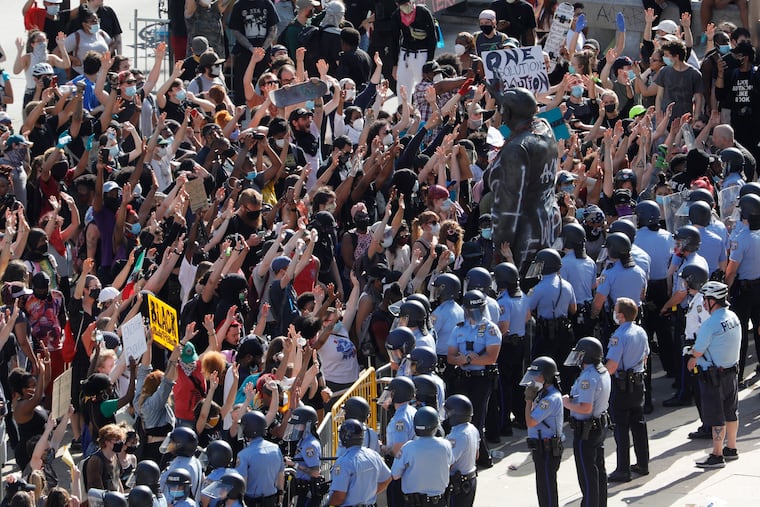SEPTA officer under investigation after Philly protesters beaten with baton
“A cop reaches over the line and bashes me with his baton. I go down immediately. ... Then I start seeing blood drip down my face and I’m hearing ringing in my ears.”

On May 30, the first day of large-scale protests against police brutality in Philadelphia, crowds coalesced around what had become a symbol of Philadelphia’s troubled police-community relationship: the statue of former Police Commissioner and Mayor Frank Rizzo.
As some used fire, ropes, hammers, and a metal barricade to try to bring it down, others, including Joe Rupprecht, 24, began to gather along the perimeter of the crowd in a defensive line.
Then, police moved in. Rupprecht said he did not hear any communication — no warning or order to clear the area. “They charged us. They were bashing people with their shields. They were picking up the barricades and swinging them toward us, just being really violent,” he said. “Then out of nowhere a cop reaches over the line and bashes me with his baton. I go down immediately and then a protester helps me get back up. I thought I was OK for a second, and then I start seeing blood drip down my face and I’m hearing ringing in my ears.”
He sustained a concussion, he said, from a gash to his head that would require 10 staples to close. To Rupprecht, his experience illustrates that the city must investigate its response to protests well beyond what happened on I-676, what Mayor Jim Kenney now calls an “unjustifiable” response in which hundreds of people were pelted with tear gas and rubber bullets as they fled from police.
A Philadelphia police spokesperson referred questions to SEPTA, because it involved a SEPTA police officer. Andrew Busch, a spokesperson for the transit agency, said the officer was placed on administrative duty pending findings from both internal affairs and criminal investigations. Busch said the agency had received reports the officer struck two people, a man and a woman, with his baton. “By Sunday, May 31, the officer’s supervising lieutenant had flagged the incident for review,” Busch said. The SEPTA Transit Police Department Board of Review is scheduled to make a recommendation based on the internal investigation this week.
But that Saturday evening, at a news conference held while Rupprecht was still receiving medical care, Kenney praised the professionalism of the police that first day, noting protesters had pelted them with insults, spit, and projectiles. He said 14 officers were injured, adding, “I’ve never seen a group of people have more restraint putting up with what they put up with.”
In an average month over the last year, Philadelphia police received eight citizen complaints of excessive force, a review of published data shows. From May 30 to June 30, 35 such complaints were lodged, 21 of them protest-related, according to a spokesperson.
About 17 minutes into aerial footage broadcast live by Fox29 during the first day of protests, bottles can indeed be seen flying toward police lines. Police can also be seen using bicycles, metal barricades, and shields to charge at protesters, and swinging their batons in the crowd where Rupprecht and others were standing.
William “Chip” Stinton, 29, a friend of Rupprecht’s who was part of the protest, termed the event a “police riot,” describing what he saw as escalation by police. He was separated from Rupprecht and did not see the baton strike him. “When I tried to find him there was blood on the ground and on people,” he said. He asked the police, “ ‘Where’s the guy that you hit?' And the police said, ‘We didn’t touch anyone.’ ”
Stinton and Rupprecht also claim that police on the scene refused to provide aid or an escort to the hospital. Busch said he was told Rupprecht had walked away and not asked for assistance.
Jerry Coleman, a trained EMT who was off duty but participating in protests, said he had seen the crowd getting aggressive, and many police staying cool. “I seen police officers get their face painted that day and didn’t even flinch,” he said. Others “crossed the line.”
He saw Rupprecht stumbling out of the crowd bleeding and helped him into his car. It took about 15 minutes to get from City Hall to the emergency room at Jefferson University Hospital because they kept running into police roadblocks. Of four they encountered, two let them pass. “They had to literally look in the backseat of the car to see someone bleeding to believe me,” he said.
Rupprecht may sue the city, said David Rudovsky, who is representing him and many other protesters. “To the extent the police were trying to clear an area because they thought damage was about to be done or it was not a peaceful protest they could tell people to leave,” he said. Instead, he said, “an officer clubbed him” without provocation.
It would be one of several impending civil rights lawsuits, including an expected action on behalf of those who were exposed to tear gas and rubber bullets during a protest on I-676 on June 1 and along the 52nd Street corridor of West Philadelphia on May 31.
The city ceased defending its response to I-676 after a New York Times video investigation compiled many of the most egregious aspects of that highly visible incident in the heart of the city. But it has not acknowledged wrongdoing on 52nd Street, where neighbors say tear gas was sprayed at curious onlookers and down residential streets.
“It was the same stuff, only this time perpetrated against Black people in West Philadelphia,” said Marni Snyder, one of a coalition of lawyers reviewing those claims. “It’s really sad when people are out protesting police brutality against Black people, and they are then brutalized by police in a predominantly African American community in or near their own homes, and there is not enough concern being shown about it.”